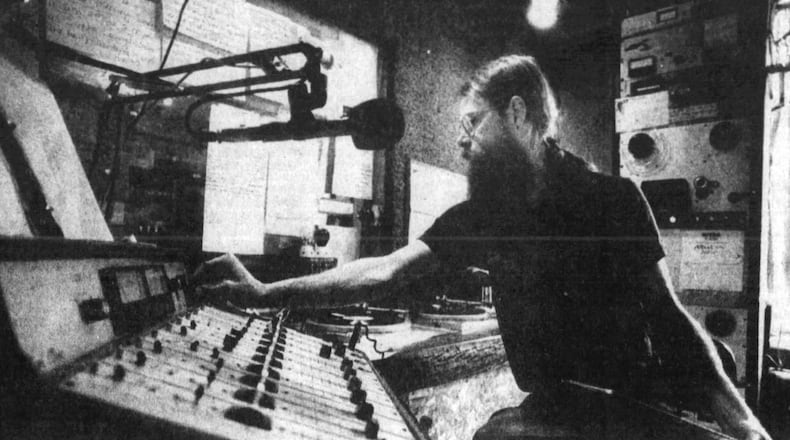Over the years the station has grown and evolved from a small college radio station to Dayton’s flagship NPR member station.
WYSO was in the news recently when it was announced that federal funding cuts were coming to PBS and NPR.
How it began
WYSO didn’t broadcast to the public until early 1958, but in December, 1957, a major step was taken when its FM antenna was installed.
Cut to length to match the station’s original frequency of 91.5 megacycles, the antenna was mounted on a 20-foot aluminum tower attached to a supporting beam on the northeast corner of Antioch’s Union building. It was 49 feet above ground level.
The first station mangers were Antioch students Ed Richards and Hal Roeth.
“We’ve still got miles of wiring to do, plus the installation of the transmitter and the setting up of the FM control console,” Richards explained at the time. “Then we’re ready to begin testing to determine the station’s radius, whether we’re on the right frequency, and if we’re really on the air. Lots of solder will be used between now and our scheduled February opening.”
The station, to which the call letters WYSO were assigned by the FCC, was expected to have an effective radius of at least eight miles.
Antioch college held a dedication ceremony for the new FM station on Feb. 8, 1958. The main speaker at the dedication was Charles F. Kettering, chairman of the Antioch board of trustees. An all-day seminar on educational broadcasting was held in connection with the event.
The station was then operated by residents of the surrounding communities as well as by students and faculty.
Credit: HANDOUT
Credit: HANDOUT
In 1960, the Federal Communications Commission granted WYSO’s request to increase its power from 16 watts to 360 watts. The new coverage area had a radius of about 15 miles.
In addition, the height of WYSO’s antenna was raised 20 feet, making it 70 feet above ground level.
Big changes in 1979
After more than five years of fundraising and legal battles, WYSO installed a new transmitter, antenna and microwave link in 1979, allowing the station to move from 91.5 to 91.3 on the dial. The change was necessary to avoid conflicts with other stations on the FM band.
Dayton didn’t have a National Public Radio station until 1979. That’s when WYSO-FM became Dayton’s first full-service public radio station. The move required WYSO to boost its power from 2,400 to 10,000 watts.
With the flip of a switch, the amplified WYSO signal could reach across the Dayton area from Greene County westward.
Shift in programming
By 2002, WYSO management had decided to shift towards a programming mix that maintained the local vibe while offering other programs of interest.
WYSO announced it was dumping its locally produced jazz shows and some other programming.
Credit: Jan Underwood
Credit: Jan Underwood
The news brought a flood of criticism from programmers, musicians and listeners of the station.
Station manager Steve Spencer’s plan was to eliminate weeknight jazz shows, the long-running Women in Music program on Sunday afternoons and the eclectic Sound Canvas show hosted Sunday afternoons by Ken Hanes.
Credit: Handout
Credit: Handout
In all, 10 volunteer DJs lost their shows and time slots.
WYSO leadership felt that the best way to serve the total listening community was to increase and improve its afternoon and early evening news block. This helped retain listeners that regularly tuned in for popular NPR programs like Morning Edition and All things Considered.
The changes were made in an effort to build WYSO’s audience, membership and donor funding. Although many dedicated listeners were unhappy at the time, the plan worked.
With the additions of the nightly business program, Marketplace, and global news show, The World, the station saw an unprecedented increase in listenership.
Sale to community group
In 2019, leaders of Antioch College assigned WYSO’s Federal Communications Commission public radio broadcast license to Miami Valley Public Media Inc., a community nonprofit organization with its own independent board.
A seven-member board of trustees was established to provide governance for the new venture. That board was chaired by William Linesch, a retired chief human resources officer and system vice president for Premier Health Network.
In exchange, Antioch received $3.5 million as partial reimbursement for its decades of investment in the station.
“The intention was always, when it was ready, that the radio station would be put in the community’s hands,” Tom Manley, Antioch president said at the time.
“Our goal was, specifically, to place the station under community control – that is, the station will be wholly independent and operated for the benefit of the community at-large,” Manley said in the statement. “That is entirely in keeping with what the founders and early volunteers had in mind 60 years ago.”
About the Author



